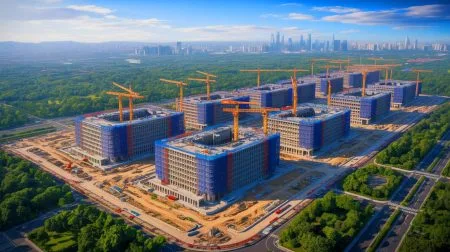| IN A NUTSHELL |
|
China’s South-to-North Water Diversion Project is a monumental engineering feat that has significantly reshaped the hydrological landscape of the nation. Since its inception in December 2014, the project has channeled over 70 billion cubic meters of water, primarily through its middle route. This colossal infrastructure serves as a critical water supply line for 26 major cities and more than 200 counties, directly benefiting approximately 114 million residents across regions such as Beijing, Tianjin, Hebei, and Henan. The project’s impact is not only quantitative in terms of water volume but also qualitative, as it contributes to ecological restoration and urban development.
Transforming Urban Water Supply in Beijing
Beijing, the bustling heart of China, has seen profound changes in its water supply system due to the South-to-North Water Diversion Project. This initiative has become indispensable, with diverted water now constituting nearly 80 percent of the capital’s urban water supply. The water travels an astonishing distance of over 620 miles from the Danjiangkou Reservoir in Hubei Province, navigating through a network of canals and pipelines.
The journey of water across such a vast distance involves crossing beneath the Yellow River, underscoring the complex engineering prowess of the project. Upon reaching Beijing, the water undergoes treatment at the city’s state-of-the-art facilities before being distributed to millions of residents. This transformation of the water supply system has not only enhanced the quality of life for urban dwellers but has also alleviated the intense pressure on local water resources.
Expansion and Impact in Tianjin
In Tianjin, the project’s reach is remarkable, extending to 15 of the city’s 16 administrative districts. The water diversion has significantly improved water access in both urban and rural settings. Infrastructure enhancements have been pivotal, with rural drinking water improvement initiatives ensuring that even remote areas benefit from the project.
The expansion of water access has facilitated various socio-economic developments in Tianjin. Agricultural productivity has increased due to reliable water supply, and the quality of life in rural areas has improved as a result of better sanitation and access to clean drinking water. This comprehensive reach of the project highlights its importance in supporting the growth and sustainability of northern China’s urban and rural landscapes.
Ecological Restoration and Environmental Benefits
Beyond urban and rural benefits, the South-to-North Water Diversion Project plays a crucial role in ecological restoration across northern China. The continuous water replenishment has combated groundwater overexploitation, a significant issue in the region. Rivers that had long suffered from diminished flow, such as the Hutuo, Yongding, and Daqing, are witnessing a revival.
This environmental rejuvenation is vital for maintaining biodiversity and ensuring the health of aquatic ecosystems. Additionally, the restoration of these water systems supports agriculture and other industries reliant on stable water supplies. The project’s environmental impact is a testament to its multifaceted benefits, addressing both human and ecological needs.
Addressing Water Scarcity in Northern China
Northern China has historically faced severe water scarcity, often classified as “absolute water scarcity” by United Nations standards. The South-to-North Water Diversion Project was conceived to address this critical issue. By channeling water from the south, where it is abundant, to the arid north, the project has become a lifeline for millions.
The initiative has not only mitigated the immediate challenges of water scarcity but has also laid the groundwork for future resilience against climate variability. As water demand continues to rise with population growth and urbanization, the project’s significance will likely increase. This strategic redistribution of water resources is essential for sustaining the livelihoods and economies of northern China.
As the South-to-North Water Diversion Project continues to evolve, its long-term impacts on China’s socio-economic and environmental landscapes remain a subject of interest. How will this ambitious project adapt to future challenges posed by climate change and evolving water demands? The answers will shape the future of water management in China and provide lessons for other nations facing similar challenges.
Did you like it? 4.4/5 (29)








Isn’t this project just a temporary fix for China’s water issues? 🤔
Wow, 620 miles! That’s quite a journey for water. 🚰
What about the environmental impact? Are there any studies on that?
Thanks for the detailed article! Really helped me understand the project’s scale.
Are local communities benefitting equally from this project, or is it mostly urban areas?
Does diverting water from the south risk creating water shortages there?
I’d like to see more data on the ecological benefits mentioned. Sounds promising!
How sustainable is this project in the face of climate change?
Seems like a band-aid solution rather than addressing the root problem. 🤷♂️
Are there any alternative solutions that China considered before this project?
This is an engineering marvel, but at what cost to the environment?
It’s amazing how technology can overcome geographical hurdles like this!
What happens to the southern areas if water sources dwindle?
Could this serve as a model for other countries facing water scarcity?
How are rural communities being educated about the benefits of this project?
I’m curious about the project’s impact on China’s agricultural sector. 🌾
Are there any international collaborations involved in this project?
Hope the infrastructure is resilient enough to withstand natural disasters. 🤞
Great article, but it would be nice to have some visuals or maps included.
This is impressive, but what about the human cost of displacement?
Does the project consider the cultural significance of the diverted water sources?
How is water quality maintained over such long distances?
Thank you for shedding light on such a complex topic!
What are the long-term plans for maintenance and upgrades to this system?
It’s a monumental task, but is it enough to solve water scarcity in the long term?
Are there any environmental restoration efforts accompanying the project?
How are decisions being made about water distribution among regions?
I’d be interested in seeing a documentary about this project! 🎥
Is there any opposition from environmental groups and how is it being addressed?
What are the financial implications for local governments involved in this project?
Seems like a logistical nightmare to manage such a vast network of pipelines!
Are there community feedback mechanisms in place to address local concerns?
Does this project have any impact on international relations with neighboring countries?
What innovative technologies are being used in the project?
How do they ensure the reliability of water delivery during peak demand times?
Is there any academic research being done on the project’s long-term effects?
Would love to see more articles like this on sustainable infrastructure!